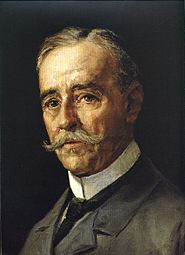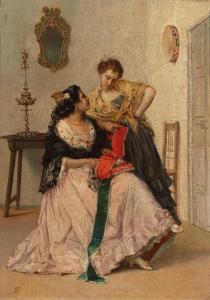Manuel Ussel de Guimbarda facts for kids
Quick facts for kids
Manuel Ussel de Guimbarda
|
|
|---|---|

Self-portrait, c.1875
|
|
| Born | 26 November 1833 |
| Died | 9 May 1907 |
| Nationality | Spanish |
| Education | Royal Academy of San Fernando, Madrid |
Manuel Ussel de Guimbarda y Malibrán (born November 26, 1833 – died May 9, 1907) was a Spanish painter. When he signed his artworks, he often spelled his last name "Wssel".
Contents
Early Life and Art Training
Manuel Ussel de Guimbarda was born in Cuba. At that time, his father, who was a soldier, was stationed there. In 1841, his mother and brother passed away. After this, his father took Manuel back to Spain. They moved to San Fernando.
In 1843, Manuel went to Madrid with his father. He enrolled at the Royal Academy of San Fernando. This was a very famous art school. There, he studied with a well-known artist named Leonardo Alenza.
A Soldier and an Artist
Even though he was studying art, Manuel decided to follow his family's tradition. He joined the military and became a Lieutenant in 1854. Just one year later, he painted his first big artwork. It was inspired by the famous Battle of Lepanto.
Later, he moved to Cartagena. He continued his art studies there. He also became involved in a local group that worked to protect old artworks and monuments. In Cartagena, he married the daughter of a rich businessman.
Focusing on Art
After his father passed away, Manuel moved to Seville. He lived there from 1867 to 1886. This is when he truly dedicated himself to being an artist. He became known as an excellent portrait painter. He also created many paintings about history and religion. Some of his works showed everyday life scenes, which are called costumbrista scenes.
During a time of political unrest called the Cantonal Revolution, Manuel became very involved in local politics. He also helped start an art group known as the Escuela de Alcalá de Guadaíra. This group got its name because they often gathered by the Guadaíra River to paint outdoors. Painting outdoors is called plein aire.
Later Career and Murals
Manuel returned to Cartagena because the area was experiencing an economic boom. This meant there was a lot of money and new businesses. He opened his own art studio and even an art school for women.
Besides his paintings, he received special requests to create large wall paintings, called murals. He also painted altarpieces, which are artworks placed behind church altars. Some of his notable works include:
- Murals and altarpieces at the "Iglesia de Santa María de Gracia" (Church of Saint Mary of Grace).
- Paintings in the "Basílica de la Caridad" (Basilica of Charity). Here, he painted the curved ceiling, known as the vault, of a chapel. He also painted images of the "Cuatro Santos de Cartagena" (Four Saints of Cartagena) on the walls.
In Lorca, he painted more murals and decorations. These artworks showed themes like industry, trade, and farming. They were located in the "Palacio Huerto Ruano," which was once a wealthy businessman's home and is now a museum. Lorca is also home to his painting "Crucifixion." This artwork is in the central part of the curved area behind the altar, called the apse, in the "Colegiata de San Patricio" church.
Manuel Ussel de Guimbarda passed away in Cartagena at the age of 73.
See also
 In Spanish: Manuel Ussel de Guimbarda para niños
In Spanish: Manuel Ussel de Guimbarda para niños



